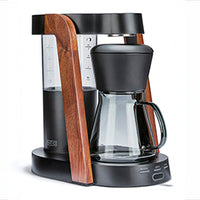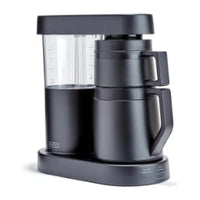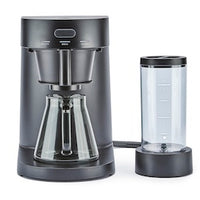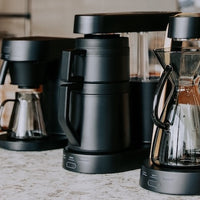Cold Brew Isn’t Just Slower Coffee
Key Takeaways
-
Cold brew and iced coffee are not the same — they differ in method, flavor, and brew time
-
Cold brew uses cold water and long steeping times to produce a smooth, low-acid cup
-
It highlights chocolatey, nutty flavors and reduces brightness and acidity
-
Brewing requires planning ahead and precise ratios to avoid muddiness or dilution
-
Quality water, coarse grind, and filtered steeping make or break the final taste
For many, cold brew is just coffee’s laid-back cousin — slower, cooler, and seemingly easier. You steep coffee in cold water, wait a bunch of hours, and voilà: cold coffee. But to treat cold brew as just “slower coffee” is to misunderstand what makes it special.
Cold brew isn’t just about temperature or timing — it’s an entirely different brewing method that transforms how your coffee tastes, feels, and functions in a cup.
Whether you’re making it at home or grabbing a bottle from the fridge, knowing what makes cold brew unique can help you craft better drinks — and understand when not to reach for it.
What Cold Brew Actually Is
Cold brew is made by steeping coarsely ground coffee in cold or room-temperature water for an extended period, usually 12 to 24 hours. Unlike iced coffee — which is hot coffee cooled down — cold brew never involves heat.
This slow extraction method pulls out different compounds than hot water would, leading to:
-
Lower acidity
-
Milder bitterness
-
Heavier body
-
Muted brightness
It’s smooth, chocolatey, and sometimes slightly sweet — even without additives. But it’s also less vibrant, making it great for certain flavor profiles, and less ideal for others.
How Cold Brew Differs From Iced Coffee
|
Feature |
Cold Brew |
Iced Coffee |
|
Brew Temp |
Cold/Room temp |
Hot |
|
Brew Time |
12–24 hrs |
2–4 min |
|
Acidity |
Low |
Medium to High |
|
Body |
Full, round |
Crisp, light |
|
Flavor |
Chocolatey, mellow |
Bright, aromatic |
|
Brew Method |
Immersion |
Pour-over or drip |
They may both be served cold, but they couldn’t be more different under the surface.
Why Cold Brew Tastes So Different
Cold water doesn’t extract as efficiently as hot water — it moves slowly, taking time to dissolve coffee’s soluble compounds.
That’s why:
-
Acidic compounds are extracted less
-
Bitterness is reduced
-
Sweetness and body increase over time
Cold brew leans into base notes: chocolate, caramel, nuts. It skips the floral, citrusy sparkle that hot methods deliver.
This makes it especially appealing to people who want something smooth and sippable without sharp edges.

How to Make Cold Brew at Home
Making cold brew isn’t complicated — but it does require attention to a few key details:
What You’ll Need
-
Coarsely ground coffee (think: breadcrumbs, not sand)
-
Cold, filtered water
-
A large jar, French press, or dedicated cold brew maker
-
A fine-mesh filter or cheesecloth
Basic Ratio
-
1:5 for concentrate (e.g. 100g coffee to 500g water)
-
1:8 for ready-to-drink (e.g. 100g coffee to 800g water)
Steps
-
Combine grounds and water
-
Stir gently to saturate all grounds
-
Cover and steep for 12–24 hours at room temp or in the fridge
-
Strain through a fine mesh or cloth
-
Store in the fridge for up to a week
Adjust the dilution when serving — concentrate is strong and meant to be cut with water, milk, or ice.
Mistakes to Avoid
Even slow coffee can go wrong if you’re not careful. Watch out for:
-
Too fine a grind: Over-extraction and bitterness
-
Low-quality water: Cold brew uses a lot — make sure it’s filtered
-
Steeping too long: Beyond 24 hours? Your cup might taste woody or dull
-
Skipping the filter step: Sediment = gritty texture and stale flavors
Great cold brew comes from clean ingredients and proper ratios — don’t just wing it.
When Cold Brew Shines (and When It Doesn’t)
Best For:
-
Mornings when you want something smooth and easy
-
Hot days when acidity feels too sharp
-
Mixing with milk, cream, or sweeteners
-
Batch brewing for the week
Less Ideal For:
-
Highlighting fruity or floral beans
-
Pairing with light, citrusy breakfasts
-
Quick cravings (it’s not instant)
Not all coffees work well for cold brew. If you love African beans with lemony sparkle or tea-like clarity, those notes may vanish in a cold brew.
Stick to Latin American or Indonesian beans with deeper flavor bases for better results.
Cold Brew and Your Equipment
While cold brew doesn’t rely on high-end brewers, your gear still matters. Clean vessels and good filters prevent off-flavors. Proper grind size ensures clarity.
If you’re starting with a consistent hot brew system — like those from Ratio Coffee — cold brew is a great contrast to explore. It teaches you how temperature changes extraction, and why method matters as much as beans.
You don’t need fancy gadgets to get it right. But you do need to respect the method.
Cold Brew Is Its Own Thing
Cold brew isn’t just iced coffee that takes longer. It’s its own technique, its own flavor profile, its own experience.
Understanding that — and brewing it with care — turns a lazy cup into a deliberate one.
It’s bold without being aggressive. Strong without the sting. And, when made well, it holds up beautifully to cream, ice, or even a splash of tonic.
So next time someone shrugs off cold brew as “just chilled coffee,” feel free to set them straight — or better yet, hand them a glass that proves the point.
Frequently Asked Questions
Is cold brew stronger than regular coffee?
Cold brew concentrate has more caffeine per ounce, but it’s typically diluted before serving. Strength depends on how you brew and mix it.
Can I heat up cold brew?
Yes — it will be smooth and less acidic than regular hot coffee. Just warm it gently.
How long does homemade cold brew last?
Up to 7 days refrigerated. Flavor is best within the first 3–4 days.
What’s the best coffee for cold brew?
Medium to dark roasts from Latin America or Indonesia tend to shine. Look for chocolatey, nutty, or caramel notes.
Do I need a cold brew maker?
No — a jar, French press, or any container with a filter will do. Simplicity works as long as your ratios and timing are right.
 Ratio Eight S2
Ratio Eight S2
 Ratio Eight Original
Ratio Eight Original
 Ratio Six
Ratio Six
 Ratio Four
Ratio Four
 Compare Machines
Compare Machines






